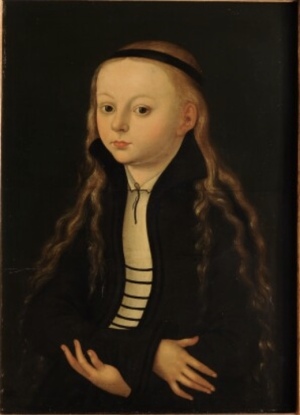Luther Visualized 12 – Marriage and Family
October 5, 2017 Leave a comment
Luther’s Marriage and Family

Oil paintings on panel by Lucas Cranach the Elder’s studio, on display at the Lutherhaus in Wittenberg. Left: Martin Luther, 1528. Right: Katharina von Bora, 1528 or later.
Martin Luther and Katharina von Bora, a runaway Cistercian nun, were betrothed and married on June 13, 1525. Neither had a strong physical or emotional attachment to the other at first, but these eventually blossomed from their commitment to each other. Martin would eventually praise his wife highly and famously said in 1531, “I wouldn’t give up my Katy for France or for Venice…” They had six children together – Johann (or Hans), Elizabeth, Magdalena (or Lena), Martin, Paul, and Margarethe – but the two older girls died prematurely.
Sources
Weimarer Ausgabe, Tischreden 4:503-504, no. 4786 (recorded by an anonymous source in the 1530s and copied by Pastor Kaspar Khummer)
Gustav Kawerau, ed., Der Briefwechsel des Justus Jonas, first half, vol. 16 of Geschichtsquellen der Provinz Sachsen und angrenzender Gebiete, ed. Historische Commission der Provinz Sachsen (Halle: Druck und Verlag von Otto Hendel, 1884), p. 94, no. 90 (14 June 1525)
Gottfried G. Krodel and Helmut T. Lehmann, eds., Luther’s Works (Philadelphia: Fortress Press, 1972), 49:116-117
Theodore G. Tappert and Helmut T. Lehmann, eds., Luther’s Works (Philadelphia: Fortress Press, 1967), 54:7-8, no. 49 (recorded by Veit Dietrich in the Summer or Fall of 1531)
Martin Brecht, Martin Luther: Shaping and Defining the Reformation, trans. James L. Schaaf (Minneapolis: Fortress Press, 1990), pp. 195-204
Martin Brecht, Martin Luther: The Preservation of the Church, trans. James L. Schaaf (Minneapolis: Fortress Press, 1993), pp. 237-238

16th century copy of Portrait of a Girl, an oil painting by Lucas Cranach the Elder. This copy hangs in the Lutherhaus in Wittenberg. It is based on the original in the Louvre in Paris, which is dated to 1520. For years the sitter was identified as Magdalena Luther (rf., e.g, the “Album of Photographs” in Schwiebert’s Luther and His Times [St. Louis: CPH, 1950]). But this identification is erroneous, since this sitter is about 10 years old and even the latest date assigned to this painting, 1528, predates Magdalena’s birth.
A funeral was held the same day Lena died, September 20, at which Luther broke down in tears. However, as the casket was being closed, Luther gathered himself enough to express his sure hope that his daughter would rise again on the Last Day. The Christian bond and character of the Luther family serves as a model to this day.